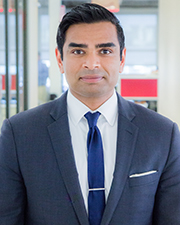2021 Ones to Watch: Sharvil Patel, Shawmut Design and Construction
 Name: Sharvil Patel
Name: Sharvil Patel
Title: Director/Regional Sector Lead
Company Name: Shawmut Design and Construction
What recent project, transaction or accomplishment are you most proud of?
We recently won a project with a local private college. During the debrief with the client and the architect, after the award and on separate calls, they both said that we really aligned ourselves well with their values—from the submission of the proposal to a strong follow through in the presentation. At Shawmut, diversity, equity, and inclusion is at the core of everything we do, so it was important that our operations team was representative of their student body. I’ve found that some of the best wins, whether with new or existing clients, have come when we’ve coalesced a submission that shows how we provide a better building experience for our clients—and how we’ve followed through on that commitment in the past.
How do you keep your team motivated despite conflicts and obstacles?
Motivation during challenging times requires a deft hand in showing teams the problems we face are rather ordinary when broken down into their components. They are often overcome with enhanced communication, empathy for those that present the obstacle to us, and by engaging our partners for a mutually beneficial outcome. Most times, a gentle nudge reminding them of past success in similar situations works. Sometimes you show them by doing alongside and letting the team know they are not in it alone.
Who was/is your mentor and how did s/he influence/help you in your career?
I have not had the pleasure of a singular mentor in my career, but rather a cohort of peers and bosses that have shaped the way I work and the outcomes that have resulted. Early, colleagues helped me improve hard skills like how to manage a schedule, report project costs, and know how things get put together. Soon after, it was learning to make timely and informed decisions, regardless of whether they were right or wrong. Later, it was improving my approach to better work with diverse skillsets and personalities. I believe I can spend a lifetime to refine this last one.
How do you contribute to your community or your profession?
I have a strong belief that education will lift our masses to a better way of life. I’ve taught within Pratt Institute’s construction management program and helped guest lecture parts of a real estate law course at Brooklyn Law School. I’ve also been fortunate enough to help contribute to improving school conditions in my grandfather’s village in India. We helped fund an enclosure around the school’s property after a visit showed the village’s main road ran very close to where the children played. More recently, I’ve joined the local chapter of the Association of Medical Facilities Professionals and their communications committee to help further dialogue surrounding healthcare construction delivery.
What did you want to be when you grew up?
At some point, I recall I wanted to be a lawyer. I was a pragmatic kid.
What led you to your current profession?
Around the time I was nearing the end of my architecture degree, my father fell ill. By the time I graduated, he was unable to work. I had been fortunate enough to intern at an owner’s rep firm and a general contractor during school. The math showed that I needed to work in construction management to help pay the bills. Luckily, my personality was also better suited to construction management. However, I still think it is a tragedy how our society has relegated much of architecture, something that should be a valued art form, to a commodity.
Top three things on your bucket list:
Break 1,000 lbs total on the big 3 lifts (squat, bench, deadlift); start a non-profit focused on reducing generational poverty; leave a legacy of buildings and spaces that helped improve the lives of people—from schools and hospitals to museums and sacred spaces.
Favorite quote:
I have two, a classic and a more modern, both in the same vein of thought.
“Iron rusts from disuse; stagnant water loses its purity and in cold weather becomes frozen; even so does inaction sap the vigor of the mind.” – Leonardo Da Vinci
“Leaders should never be satisfied. They must always strive to improve, and they must build that mind-set into the team. They must face the facts through a realistic, brutally honest assessment of themselves and their team’s performance. Identifying weaknesses, good leaders seek to strengthen them and come up with a plan to overcome challenges. The best teams anywhere, like the SEAL Teams, are constantly looking to improve, add capability, and push the standards higher. It starts with the individual and spreads to each of the team members until this becomes the culture, the new standard. The recognition that there are no bad teams, only bad leaders…” – Jocko Willink
Over half of Long Island towns vote to exceed the tax cap - Here’s how owners can respond - by Brad and Sean Cronin


The strategy of co-op busting in commercial real estate - by Robert Khodadadian

Oldies but goodies: The value of long-term ownership in rent-stabilized assets - by Shallini Mehra

Properly serving a lien law Section 59 Demand - by Bret McCabe







.png)


.jpg)
.gif)